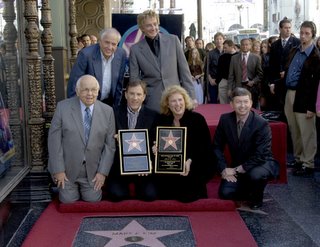 Listening In
Listening InFebruary 17, 2006
By Sandy Wells
KOST’s Mark and Kim land spot on Hollywood Walk of Fame
Los Angeles radio’s longest-running morning show received their due with a star on the Hollywood Walk of Fame this month. KOST-FM 103.5’s Mark and Kim were on hand for the unveiling of their names Feb 1st. Pop singing star Barry Manilow and noted TV, film and theatre producer Garry Marshall were among the celebs at the event near Disney’s El Capitan Theatre hosted by Hollywood’s Honorary Mayor Johnny Grant.
For Mark Wallengren and Kim Amidon, having Manilow at the ceremony was special since he was the first in-studio guest the duo had on their show.
According to Arbitron, KOST’s Mark and Kim Show has been a top five program among adult women listeners for 19 consecutive years. In the fall ratings, the team was No. 8 among listeners 12-plus and KOST was LA’s No. 1 station.
The pair has been nominated for numerous awards, and has won two Marconi’s, eight Billboard Awards, and four Gavin Awards. The Mark and Kim Show debuted on KOST in 1985.
New program head at KRLA-AM 870
Salem Communication’s flagship talker KRLA-AM 870 and the Inland Empire’s KTIE-AM 590 have ended its search for a new program director with the hiring of Craig Edwards. Edwards recently served as vice president, regional director of operations for Metro Networks/Westwood One and previously as director of operations, Los Angeles and as news bureau chief, Los Angeles. A veteran broadcaster, his experience includes positions at WTAM in Cleveland, as news director at WGR in Buffalo, and as traffic personality at KHOW in Denver.
New radio merger
Once again the radio landscape has been dramatically altered by a major merger. But it’s been a decade since the media world was shaken by the Telecommunications Act of 1996 and the subsequent “merger mania.” This latest merger is more like an aftershock. In this case, Disney Company, in a long anticipated move, has merged 22 ABC radio stations plus the ABC radio networks, except for ESPN and Radio Disney to Citadel Broadcasting Corp. for a cash and stock deal estimated at $2.7billion. The new company, Citadel Communications will be the nation’s third-largest radio company. Citadel CEO Farid Suleman, the former CEO of Infinity Broadcasting, will lead the new management team.
There is no telling right now what the ultimate impact on ABC stations will be. Here, it means that album rock KLOS-FM 95.5 and talk station KABC-AM 790 will now be part of Citadel. KSPN-AM 710 and KDIS-AM 1110 will remain within the Disney family of companies.
Among the major radio networks, ABC radio adapted best to the changing times of the 1960s creating specially targeted newscasts for different radio stations formats and a chain of highly successful top 40 rock stations that appealed to the younger audiences. It was the company that gave birth to the full time talk radio format right here in Los Angeles at KABC in the early 1960s.
More recently, ABC led the way in talk radio syndication developing stars such as Rush Limbaugh, Sean Hannity and Larry Elder. Paul Harvey News and Comment and the top of the hour news summaries have maintained their relevance and appeal despite the growth of less-formal, longer-form news and talk presentations.
Commercial radio in LA is still cash cow
Even with the competition from podcasting, iPods and satellite radio, commercial terrestrial radio remains a very healthy industry. The Southern California Broadcasters Association recently released their figures on ad revenues for 2005 and the 59 stations in LA and Orange Counties was $1.080 billion, a 3.4 percent gain over 2004. The Los Angeles Media Market, defined as the five county area including Los Angles, Orange, Riverside, San Bernardino, and Ventura Counties took in $1.130 billion.
According to SCBA President Mary Beth Garber, Southern California is the world’s No. 1 radio revenue because of long commutes.
“Radio is growing because more advertisers understand how consumers use different media. Working people in Los Angles spend 3 ½ hours each workday with radio, just between 5 a.m. and 8 p.m. … Because we’re not at home we look for companionship and connection. We don’t use radio just as a music delivery system (like an iPod, CD, Muzak or satellite radio). We look for emotional connection, for virtual neighborhoods.”
Radio certainly has proved remarkably resilient in the past. It could end up being like the cockroach of electronic media. Having survived onslaughts from TV, audio cassettes, CDs and cable radio, it seems likely to survive satellite radio and the Internet. Radio, thanks to its ubiquity and low-tech ease of use, will around long after many more exotic and more spectacular media delivery systems become extinct. Now if radio executives could just convince more people to buy the new HD radios ...
No comments:
Post a Comment